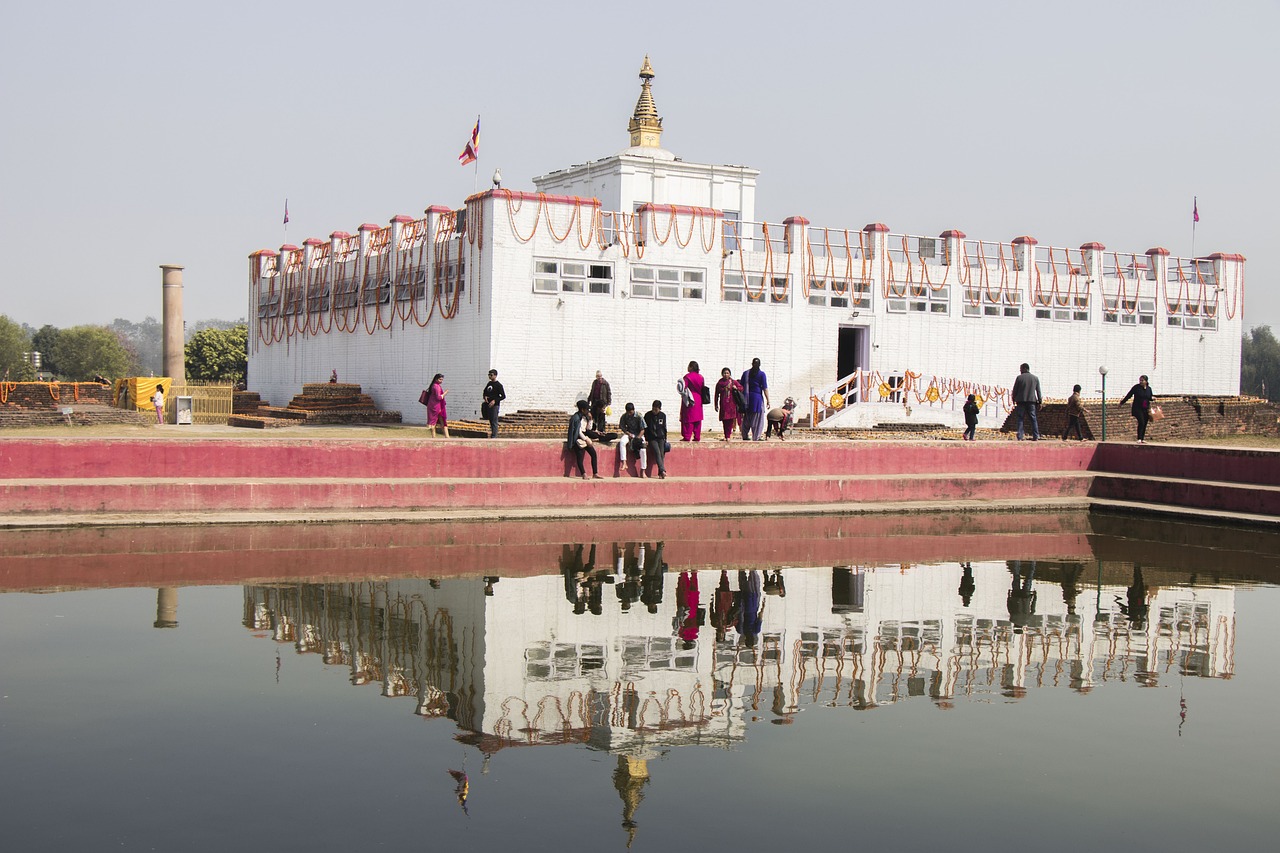Lumbini, nestled in the plains of southern Nepal, is one of the most sacred and significant places for Buddhists around the world. It is the birthplace of Siddhartha Gautama, who later became known as Gautam Buddha, the founder of Buddhism. Declared a UNESCO World Heritage Site in 1997, Lumbini is not just a place of historical importance but also a center of peace, reflection, and spirituality, attracting pilgrims and tourists alike from every corner of the globe. In this blog post, we explore the rich history, geography, and cultural significance of Lumbini, while also touching on some of the controversies surrounding this sacred site.
Historical Significance of Lumbini
Lumbini’s history is inextricably linked with the life of Gautam Buddha. According to Buddhist tradition, Siddhartha Gautama was born in Lumbini around 563 BCE to Queen Mayadevi, the wife of King Suddhodana of the Shakya dynasty. As legend has it, Queen Mayadevi gave birth to Siddhartha while holding onto a branch of a sal tree in the garden of Lumbini during her journey to her parental home.
The significance of Lumbini as a pilgrimage site dates back centuries. Emperor Ashoka of India, a devout follower of Buddhism, visited Lumbini in 249 BCE and erected the famous Ashoka Pillar, commemorating the site as the birthplace of Buddha. This pillar, bearing inscriptions in Brahmi script, remains one of the most important archaeological finds in the region and serves as a testament to Lumbini’s ancient history.
In the centuries that followed, Lumbini’s prominence as a religious center faded, and the site was largely forgotten. It wasn’t until the late 19th century, when the Ashoka Pillar was rediscovered by a German archaeologist, that Lumbini regained its rightful place as a key site for Buddhists and historians alike.
Geography of Lumbini
Lumbini is situated in the Rupandehi district of Nepal, close to the Indian border. The region lies in the Terai plains, characterized by flat agricultural lands, warm climates, and a landscape vastly different from Nepal’s rugged Himalayan terrain. Lumbini is roughly 300 kilometers southwest of Kathmandu, Nepal’s capital, and can be reached via road or air through nearby airports.
The Lumbini Development Zone, a master-planned area spanning 4.8 square miles, is the focal point for visitors. The site includes the sacred Lumbini Garden, monasteries, meditation centers, museums, and various monuments. The landscape is dotted with tranquil ponds, ancient ruins, and lush greenery, providing a peaceful ambiance for those seeking spiritual reflection.
Famous Sites in Lumbini
Lumbini is home to several important landmarks that hold immense cultural and spiritual significance:
- The Maya Devi Temple: The Maya Devi Temple is the main attraction in Lumbini, marking the exact spot where Queen Mayadevi gave birth to Siddhartha Gautama. The temple houses ancient relics, including a stone marker that is believed to indicate the precise location of Buddha’s birth. Nearby, the Sacred Pond, known as the Pushkarini, is where Queen Mayadevi is said to have bathed before giving birth.
- Ashoka Pillar: Erected by Emperor Ashoka in 249 BCE, the Ashoka Pillar is one of the oldest monuments in Lumbini and serves as a historical marker of the site’s importance. The inscriptions on the pillar celebrate Lumbini as the birthplace of Buddha and signify Ashoka’s dedication to spreading the teachings of Buddhism.
- Monastic Zone: Lumbini is also home to a monastic zone, which includes numerous monasteries built by various countries, each representing different schools of Buddhist thought. These monasteries, including those from countries like Thailand, Japan, China, and Sri Lanka, showcase diverse architectural styles and provide spaces for meditation and learning.
- World Peace Pagoda: The World Peace Pagoda, constructed by Japanese Buddhists, stands as a symbol of peace and harmony. It is a beautiful white structure located within the Lumbini complex, drawing visitors with its serene atmosphere and panoramic views.
- Lumbini Museum: The Lumbini Museum provides insights into the history of the region, displaying artifacts, sculptures, and manuscripts related to Buddha’s life and the development of Buddhism over the centuries.
Controversy Surrounding Lumbini
Despite its historical and spiritual significance, Lumbini has been the subject of controversy, particularly regarding its status as the true birthplace of Gautam Buddha. While Nepal maintains that Lumbini is the authentic birthplace, some Indian scholars and historians have questioned this claim, suggesting alternative sites in India. The controversy stems from the proximity of Lumbini to the India-Nepal border and has occasionally fueled political tensions between the two nations.
Nepal, however, holds a strong historical and archaeological record to back its claim, with the Ashoka Pillar standing as a critical piece of evidence. The controversy, though significant in academic circles, does not deter the millions of pilgrims who continue to visit Lumbini to pay their respects and seek spiritual solace.
Another challenge facing Lumbini is the development of the area. While the Lumbini Development Trust has made significant efforts to preserve the sanctity of the site, concerns about commercialization, improper management, and environmental degradation have been raised. Balancing the demands of modern tourism with the need to preserve Lumbini’s spiritual and historical integrity remains an ongoing struggle.
Lumbini: A Place of Peace and Reflection
Lumbini’s significance transcends the controversies and challenges surrounding it. For Buddhists, it is the birthplace of one of the most revered figures in human history, a place of pilgrimage and spiritual renewal. For others, it is a peaceful destination that offers a glimpse into Nepal’s rich cultural and religious heritage.
Visitors to Lumbini often leave with a profound sense of peace, having walked in the footsteps of Gautam Buddha. Whether for historical curiosity, spiritual enlightenment, or personal reflection, Lumbini continues to inspire and attract people from all walks of life.
Conclusion
Lumbini, the birthplace of Gautam Buddha, is more than just a historical site — it is a symbol of peace, wisdom, and spiritual awakening. With its rich history, serene geography, and famous landmarks, Lumbini remains a beacon of hope and inspiration for Buddhists and non-Buddhists alike. Despite the controversies and challenges that surround it, Lumbini’s legacy as the cradle of Buddhism endures, continuing to draw visitors from across the globe who seek to connect with the teachings and the life of the Buddha.
FAQs
1. Why is Lumbini important in Buddhism?
Lumbini is the birthplace of Siddhartha Gautama, who later became known as Gautam Buddha, the founder of Buddhism. It is one of the holiest pilgrimage sites for Buddhists, symbolizing the beginning of Buddha’s journey toward enlightenment and his teachings of peace and compassion.
2. Where is Lumbini located?
Lumbini is located in the Rupandehi district of southern Nepal, near the Indian border. It lies in the Terai plains, about 300 kilometers southwest of Kathmandu, Nepal’s capital.
3. What are the key attractions in Lumbini?
The key attractions include the Maya Devi Temple, which marks the exact spot of Buddha’s birth, the Ashoka Pillar erected by Emperor Ashoka in 249 BCE, the World Peace Pagoda, and the Monastic Zone, where various countries have built monasteries representing different schools of Buddhist thought.
4. Is there any controversy surrounding Lumbini’s status as Buddha’s birthplace?
Yes, some historians and scholars have raised questions about the exact birthplace of Gautam Buddha, with alternative locations suggested in India. However, Nepal maintains that Lumbini is the authentic birthplace, supported by historical evidence like the Ashoka Pillar.
5. How can I visit Lumbini?
Lumbini can be accessed by road from major cities in Nepal and India. The nearest airport is in Bhairahawa (Gautam Buddha International Airport), about 22 kilometers from Lumbini, with regular flights from Kathmandu. Visitors can explore the Lumbini Development Zone, which includes temples, monasteries, and peaceful gardens.





